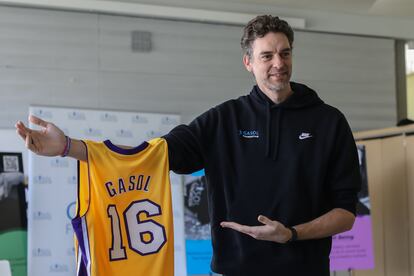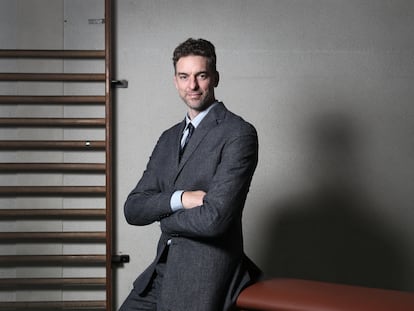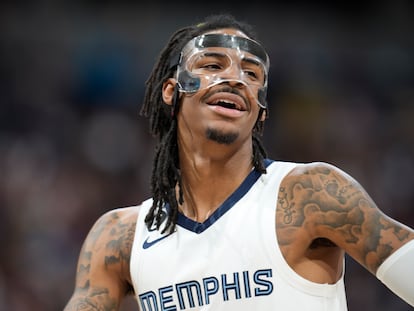Pau Gasol: ‘It’s dizzying to realize that your name, your family, your dreams are part of such an exceptional group’
The number 16 shirt with which the Spanish player won two NBA titles at the Los Angeles Lakers was ceremoniously retired on Tuesday


The moment Pau Gasol walks into the Lafayette Park gymnasium – all 7′1″ of him – everything goes quiet. About 20 kids from a couple of public schools stop dribbling a basketball with the Lakers logo, unable to hide their surprise. They stare in awe at the giant before them. Seconds later, the children, from the Everest and Rise Kohgang schools, swarm around the Spanish NBA legend, who gets showered with questions: “Who is your favorite player?” “What was it like playing with Kobe Bryant?” “How tall are you?”
That was last Monday. The next day, March 7, Gasol joined the gods of the American professional league after he became the 12th Laker to have his jersey retired. Now his name will shine in perpetuity alongside those of Kareem Abdul Jabbar, Wilt Chamberlain, Jerry West, Shaquille O’Neal, Earvin “Magic” Johnson and, of course, Kobe Bryant.
“These are players and names that marked an era. It’s an amazing group and it’s dizzying to realize that your name, your family, your dreams and, I’d like to think, my country, are part of such an exceptional group. It’s overwhelming, it’s too much,” Gasol tells EL PAÍS. Not even as a boy – the son of two doctors, Agustí and Marisa, who used to play on a court near the Sagrada Familia church in Barcelona when he was the same age as the kids who now gawp up at him – did he ever dream that he would reach one of the most prominent teams in the NBA, where he played in three NBA finals and won two consecutive championships, in 2009 and 2010.
That dream even seemed distant during the early days after Gasol had first pulled on the yellow jersey. He had come to LA in February 2008 from Memphis, a team that had posted 20 wins for the season. The operation is still remembered as one of the Lakers’ best moves. The franchise transferred Kwame Brown, Javaris Crittenton and Aaron McKie (in addition to the rights to his brother, Marc) to the Grizzlies, in order to get Pau, a center who was the first non-American to win the rookie of the year award, in 2002.
22, 13, 44, 25, 52, 33, 32, 42. Eight imposing numbers were present at the Lakers facilities where he trained, the same courts that Magic Johnson and James Worthy stepped on. “The retired numbers are also there, but you don’t give in to those distractions, although it’s a motivation, no doubt. You want to live up to it and you think that maybe, at some point, it would be nice if your name was there, but you don’t let it go to your head,” says Gasol, who was inspired to reach the NBA after watching the US Dream Team that played in Barcelona, his hometown, at the 1992 Olympics. Now, the number 16 will never be worn by another Laker.

The jersey retirement took place at halftime during a game between the Lakers and the Grizzlies. The occasion was a perfect moment for Gasol, now 42, to reflect on his impressive career: 11 medals with the Spain team (four of them gold), three league titles and a cup win with Barcelona, in addition to his NBA achievements, where he was part of the All-Star team six times and wore the jerseys of Memphis, the Lakers, the Chicago Bulls, the Portland Trail Blazers and the Milwaukee Bucks.
On Monday, Gasol stated that one of his greatest legacies was reversing the notion that European players are technically stylish but are soft on the court compared to Americans. Gasol experienced that criticism firsthand when the Lakers were defeated by the Celtics in the 2008 championship series. He was outplayed by Kevin Garnett and Paul Pierce, and had more turnovers than points in the final game. “I knew I had to take a step forward to be better physically prepared. I got to work to win the following season, the 2008-09 season. And we won,” he says.
In order to achieve this, Gasol pushed himself to the limit. It was a turning point for his career in Los Angeles; one year later, he had gained 15 pounds of muscle. In addition, there was another source of motivation embodied by Bryant. “He challenged me so we could win. In the end, life and sport put you to the test and condition you with adverse moments. If you learn, you overcome and grow. You get stronger. That’s what happened,” he says.
The NBA is very different now. For example, two of the current All-Stars, Luka Doncic and Nikola Jokic, are European. Gasol believes he is partly responsible for this league with fewer borders: “I have contributed my two cents to open doors, to widen that path and help basketball and the presence of international players grow. I’m very proud,” declares the center, who in turn is following in the trailblazing footsteps of others like Drazen Petrovic, Vlade Divac, Peja Stojakovic and, more recently, Dirk Nowitzki, who arrived in American basketball two years before Pau.
Gasol, who retired in October 2021, has turned to philanthropic activities. Although that is a path that many celebrities follow after they retire, solidarity was always present throughout his playing career. He contributed spinal surgeries at children’s hospitals in every city he played for, visited refugees in Iraq and Syria and vowed to donate $1,000 for every point he scored to help typhoon victims in the Philippines. Since 2013, along with his brother Marc, he has led the Gasol Foundation, which teaches children better eating habits and physical activities to combat childhood obesity.
On Monday, he told the children about the first injury that left a mark on his memory. He was 12 years old and was playing in the schoolyard when he twisted his finger. “I had never felt such pain, but my love for the sport was greater, so I pushed myself to continue playing. In basketball and in life, sometimes you have to push through pain and hardship. That makes you better.” He won that match, he said. Perhaps his words have created more than one dream of reaching the NBA.
Sign up for our weekly newsletter to get more English-language news coverage from EL PAÍS USA Edition
Tu suscripción se está usando en otro dispositivo
¿Quieres añadir otro usuario a tu suscripción?
Si continúas leyendo en este dispositivo, no se podrá leer en el otro.
FlechaTu suscripción se está usando en otro dispositivo y solo puedes acceder a EL PAÍS desde un dispositivo a la vez.
Si quieres compartir tu cuenta, cambia tu suscripción a la modalidad Premium, así podrás añadir otro usuario. Cada uno accederá con su propia cuenta de email, lo que os permitirá personalizar vuestra experiencia en EL PAÍS.
¿Tienes una suscripción de empresa? Accede aquí para contratar más cuentas.
En el caso de no saber quién está usando tu cuenta, te recomendamos cambiar tu contraseña aquí.
Si decides continuar compartiendo tu cuenta, este mensaje se mostrará en tu dispositivo y en el de la otra persona que está usando tu cuenta de forma indefinida, afectando a tu experiencia de lectura. Puedes consultar aquí los términos y condiciones de la suscripción digital.
More information
Archived In
Últimas noticias
Welcome to the post-religion era: The idea of Christianity as the absolute truth has become obsolete
‘I thought you would like it’: The risky sexual practice popularized by TV shows and TikTok
The digitalization of tourism: ‘They promise experiences and gave us the worst possible one’
Mexican peso defies uncertainty with forecasts of a new period of stability in 2026
Most viewed
- Sinaloa Cartel war is taking its toll on Los Chapitos
- Oona Chaplin: ‘I told James Cameron that I was living in a treehouse and starting a permaculture project with a friend’
- Reinhard Genzel, Nobel laureate in physics: ‘One-minute videos will never give you the truth’
- Why the price of coffee has skyrocketed: from Brazilian plantations to specialty coffee houses
- Silver prices are going crazy: This is what’s fueling the rally










































